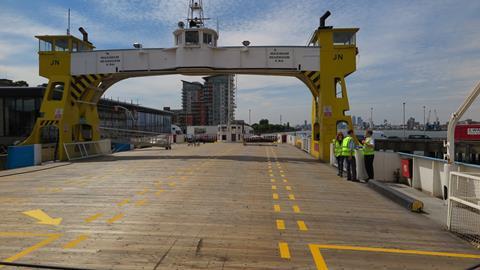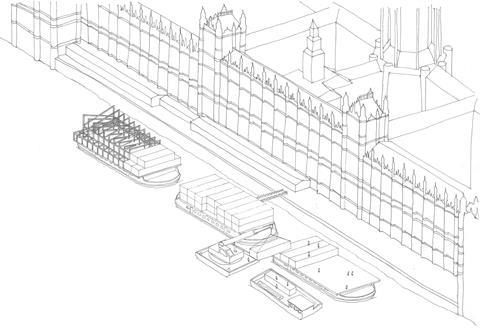Studio Octopi founder criticises ‘eye-watering waste’ of AHMM and Hopkins proposals

Studio Octopi founder Chris Romer-Lee has criticised MPs for dismissing a fully costed proposal to rehouse MPs on the Woolwich Ferry.
The architect of the £55m HMS Parliament idea accused them of presiding over “spectacular waste” – financial, environmental and architectural.
His intervention comes after plans by AHMM to build a temporary chamber on the site of listed Richmond House were criticised by conservationists.
At the same time Michael Hopkins revealed a counter proposal to use the atrium of Portcullis House while the Palace of Westminster is restored.
Romer-Lee, who was in talks with MP Chris Bryant about the ferry idea at the end of last year, said it would have saved the taxpayer a vast amount of money as well as being more sustainable than AHMM’s plans.

The architect teamed up with Expedition Engineering, marine engineer Beckett Rankine and naval architect Houlder to work up the plans, which were costed by Jackson Coles and given security approval by consultant Securewest.
The ‘houseboat of Commons’ idea came to marine engineer Tim Beckett when he realised the Commons and Lords chambers were the same size as the 55-year-old ferries which were due to be decommissioned at exactly the right moment. The third ferry would have contained the meeting rooms and offices.
Because they were owned by the state they could have been commandeered for the project at no cost to the taxpayer, said Romer-Lee.
Instead they have been sold to an EU scrap merchant for £37,000 each.

Politicians “had no appetite” for the unusual proposals, said Romer-Lee, who is the architect behind the Thames Baths and other floating projects.
He added: “Eliminating waste is something the construction industry is focused on and here we were presenting a scheme that created barely any waste. In fact it was upcycling decommissioned infrastructure.
“From what I read the level of waste for any of the schemes on the table is eye-watering.”
He added: “As the squabbling starts over which building is to be mauled, the Woolwich Ferries are being scrapped on the continent, each sold for the cost of a mid-range new electric car.
“Even with Richmond House as one temporary chamber there is still the extensive works converting the QEII Conference Centre into the [Lords’] chamber, which is once again demolition, fit-out and then reinstating the conference centre. Waste on an unprecedented level.”

Hopkins’ scheme was better, he said – but still involved demolition, fit-out and reinstating.
Hopkins’ Portcullis House proposal has been backed by Save Britain’s Heritage which is campaigning against the demolition of Richmond House.
Today it was joined by the Twentieth Century Society whose head of casework Clare Price said: “We are shocked at these plans and furious that despite repeatedly asking the government for a meeting to discuss this sensitive scheme and Sir Michael’s alternative plans, we are still waiting for this to happen. It is beholden on them to demonstrate openness and transparency and this is just not happening.”
Gensler was the first architect to propose a floating Parliament in 2016, although its Project Poseidon proposals would have cost £160m.














22 Readers' comments